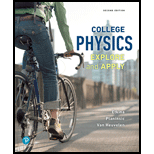
Concept explainers
BIO Muscles work in pairs Skeletal muscles produce movements by pulling on tendons, which in turn pull on bones. Usually, a muscle is attached to two bones via a tendon on each end of the muscle. When the muscle contracts, it moves one bone toward the other. The other bone remains in nearly the original position. The point where a muscle tendon is attached to the stationary bone is called the origin. The point where the other muscle tendon is attached to the movable bone is called the insertion. The origin is like the part of a door spring that is attached to the doorframe. The insertion is similar to the part of the spring that is attached to the movable door.
During movement, bones act as levers and joints act as axes of rotation for these levers. Most movements require several skeletal muscles working in groups, because a muscle can only exert a pull and not a push. In addition, most skeletal muscles are arranged in opposing pairs at joints. Muscles that bring two limbs together are called flexor muscles (such as the biceps muscle in the upper arm in Figure 8.25). Those that cause the limb to extend outward are called extensor muscles (such as the triceps muscle in the upper arm). The flexor muscle is used when you hold a heavy object in your hand; the extensor muscle can be used, for example, to extend your arm when you throw a ball.
In Figure 8.25, how far in centimeters from the axis of rotation are the forces that the ball exerts on the hand, that the biceps exerts on your forearm, and that the upper arm exerts on your forearm at the elbow joint?
a. 0, 5, 35
b. 35, 5, 0
c. 35, 5, 3
d. 35, 5,–3
e. 30, 5, 0
Want to see the full answer?
Check out a sample textbook solution
Chapter 8 Solutions
EBK COLLEGE PHYSICS
Additional Science Textbook Solutions
Genetic Analysis: An Integrated Approach (3rd Edition)
Microbiology: An Introduction
Organic Chemistry (8th Edition)
Human Physiology: An Integrated Approach (8th Edition)
Microbiology: An Introduction
Campbell Biology in Focus (2nd Edition)
- pls help on all asked questions kindlyarrow_forward19. Mount Everest, Earth's highest mountain above sea level, has a peak of 8849 m above sea level. Assume that sea level defines the height of Earth's surface. (re = 6.38 × 106 m, ME = 5.98 × 1024 kg, G = 6.67 × 10 -11 Nm²/kg²) a. Calculate the strength of Earth's gravitational field at a point at the peak of Mount Everest. b. What is the ratio of the strength of Earth's gravitational field at a point 644416m below the surface of the Earth to a point at the top of Mount Everest? C. A tourist watching the sunrise on top of Mount Everest observes a satellite orbiting Earth at an altitude 3580 km above his position. Determine the speed of the satellite.arrow_forwardpls help on allarrow_forward
- pls help on allarrow_forward6. As the distance between two charges decreases, the magnitude of the electric potential energy of the two-charge system: a) Always increases b) Always decreases c) Increases if the charges have the same sign, decreases if they have the opposite signs d) Increases if the charges have the opposite sign, decreases if they have the same sign 7. To analyze the motion of an elastic collision between two charged particles we use conservation of & a) Energy, Velocity b) Momentum, Force c) Mass, Momentum d) Energy, Momentum e) Kinetic Energy, Potential Energyarrow_forwardpls help on all asked questions kindlyarrow_forward
- pls help on all asked questions kindlyarrow_forward17. Two charges, one of charge +2.5 × 10-5 C and the other of charge +3.7 × 10-6 C, are 25.0 cm apart. The +2.5 × 10−5 C charge is to the left of the +3.7 × 10−6 C charge. a. Draw a diagram showing the point charges and label a point Y that is 20.0 cm to the left of the +3.7 × 10-6 C charge, on the line connecting the charges. (Field lines do not need to be drawn.) b. Calculate the net electric field at point Y.arrow_forward3arrow_forward
 College PhysicsPhysicsISBN:9781938168000Author:Paul Peter Urone, Roger HinrichsPublisher:OpenStax College
College PhysicsPhysicsISBN:9781938168000Author:Paul Peter Urone, Roger HinrichsPublisher:OpenStax College Principles of Physics: A Calculus-Based TextPhysicsISBN:9781133104261Author:Raymond A. Serway, John W. JewettPublisher:Cengage Learning
Principles of Physics: A Calculus-Based TextPhysicsISBN:9781133104261Author:Raymond A. Serway, John W. JewettPublisher:Cengage Learning Physics for Scientists and EngineersPhysicsISBN:9781337553278Author:Raymond A. Serway, John W. JewettPublisher:Cengage Learning
Physics for Scientists and EngineersPhysicsISBN:9781337553278Author:Raymond A. Serway, John W. JewettPublisher:Cengage Learning Physics for Scientists and Engineers with Modern ...PhysicsISBN:9781337553292Author:Raymond A. Serway, John W. JewettPublisher:Cengage Learning
Physics for Scientists and Engineers with Modern ...PhysicsISBN:9781337553292Author:Raymond A. Serway, John W. JewettPublisher:Cengage Learning Physics for Scientists and Engineers, Technology ...PhysicsISBN:9781305116399Author:Raymond A. Serway, John W. JewettPublisher:Cengage Learning
Physics for Scientists and Engineers, Technology ...PhysicsISBN:9781305116399Author:Raymond A. Serway, John W. JewettPublisher:Cengage Learning College PhysicsPhysicsISBN:9781305952300Author:Raymond A. Serway, Chris VuillePublisher:Cengage Learning
College PhysicsPhysicsISBN:9781305952300Author:Raymond A. Serway, Chris VuillePublisher:Cengage Learning





